Recognizing the signs of ovulation is key to tracking your cycle and improving your chances of conception. Look for changes in cervical mucus, which becomes clear and stretchy like egg whites. You might experience mild cramping on one side, known as mittelschmerz, and a slight rise in your basal body temperature right after ovulation. Heightened libido and breast tenderness can also signal that you’re ovulating. If you’re keen to learn how to enhance your tracking methods, there’s more to explore.
Key Takeaways
- Monitor cervical mucus changes; it becomes clear, slippery, and stretchy as ovulation approaches, indicating peak fertility.
- Track basal body temperature; a slight rise after ovulation signifies increased progesterone levels.
- Use ovulation predictor kits to detect the LH surge in urine, indicating imminent ovulation.
- Note any ovulation pain (mittelschmerz), which may manifest as mild cramps on one side of the abdomen.
- Observe changes in libido, breast tenderness, or mild bloating, which may signal the approach of ovulation.
Understanding Ovulation
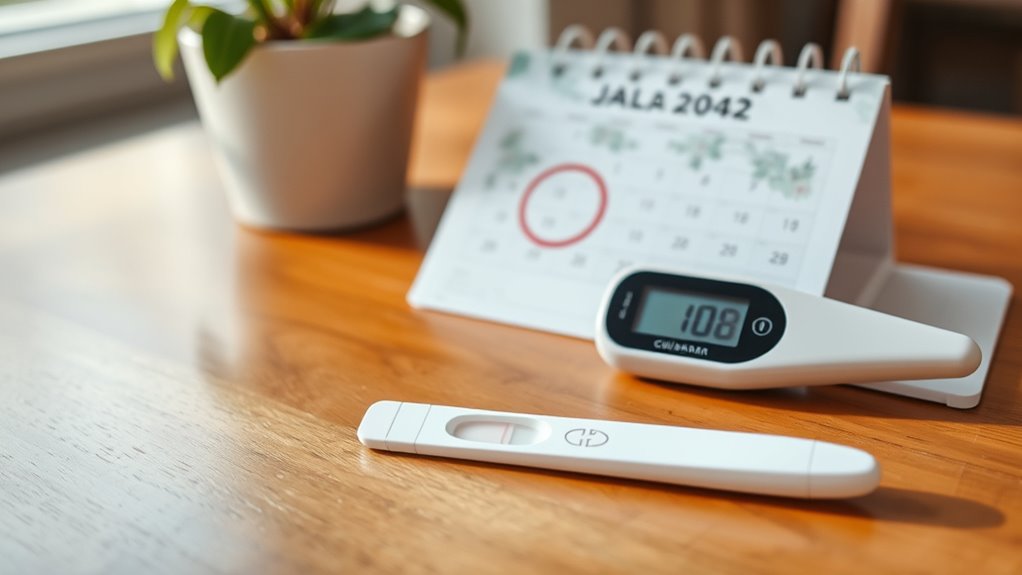
Understanding ovulation is key to maximizing your chances of conception. Ovulation is the process where a mature egg is released from your ovary, typically around day 14 of a 28-day menstrual cycle, though this can vary. This egg is viable for fertilization for about 12 to 24 hours, while sperm can last up to 5 days in your reproductive tract.
To identify ovulation, pay attention to changes in your cervical mucus, which becomes clear, slippery, and stretchy, resembling raw egg whites during peak fertility. Hormonal shifts, especially the surge in luteinizing hormone (LH), signal ovulation. Financial aid sources can also influence hormonal balance, which may affect ovulation. Additionally, maintaining a healthy emotional well-being can play a crucial role in regulating your menstrual cycle and improving fertility.
Recognizing these signs helps you time intercourse for the best chances of pregnancy, ideally in the days leading up to and including ovulation.
Importance of Tracking Ovulation

Tracking ovulation plays a vital role in enhancing your chances of conception. By monitoring your menstrual cycle, you can pinpoint your fertile window, which usually includes the five days before ovulation and the day itself. This knowledge helps you time intercourse for the best chance of pregnancy.
Pay attention to changes in your cervical mucus; when it becomes slippery and stretchy, it signals that ovulation is near. Additionally, tracking your basal body temperature can help confirm ovulation after it occurs, as you’ll notice a slight increase due to progesterone. Research shows that regular tracking can lead to a better understanding of your cycle and improve the chances of conception, especially when paired with natural remedies to support reproductive health. Furthermore, being aware of small mistakes in your tracking methods can enhance accuracy and effectiveness.
Utilizing ovulation predictor kits can also provide precise information on hormonal surges that precede ovulation, making it easier to identify your most fertile days and boost your chances of conception. Incorporating healthy fats into your diet, such as those found in avocados, can also support overall reproductive health.
Signs of Ovulation
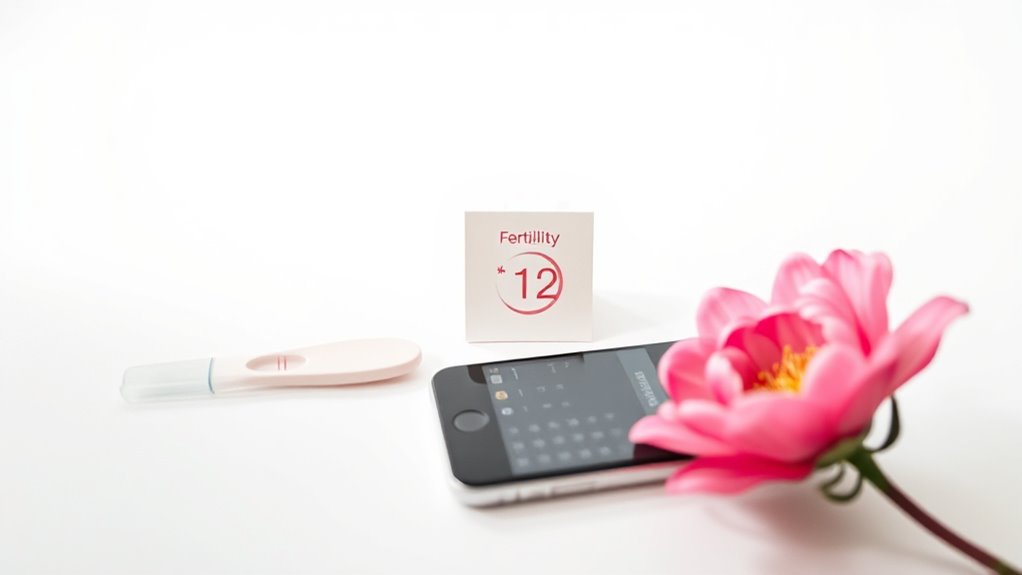
When you’re approaching ovulation, your body sends out several signals that can help you identify this crucial time in your cycle.
One of the most noticeable signs is a change in cervical mucus; it becomes clear, stretchy, and resembles raw egg whites, aiding sperm movement. Individuals with emotional dysregulation may also experience heightened sensitivity during this time, which can impact their overall well-being. It’s essential to be aware that postpartum sexual activity may require additional consideration if you’re recently postpartum.
You might also experience ovulation pain, known as mittelschmerz, which feels like a mild ache or cramp on one side of your lower abdomen.
Monitoring your basal body temperature (BBT) can be useful, as it rises slightly after ovulation due to increased progesterone levels.
Additionally, you might notice heightened libido, breast tenderness, or mild bloating as your hormones shift, all signaling that ovulation is near. Understanding these signs can improve your awareness of your cycle and enhance customer experience through natural language processing, making it easier to track your fertility.
Changes in Cervical Mucus

As you get closer to ovulation, you’ll notice significant changes in your cervical mucus. Early in your cycle, it might feel dry or sticky. As ovulation approaches, cervical mucus changes to a slippery, stretchy consistency, resembling raw egg whites, indicating peak fertility. Recognizing these patterns helps you track your menstrual cycle effectively. Additionally, tracking your cycle can be as crucial as understanding the shelf life of freshly squeezed juices to ensure optimal health and wellness.
| Cycle Phase | Cervical Mucus Consistency |
|---|---|
| Menstrual Phase | Dry or Sticky |
| Pre-Ovulation | Creamy |
| Ovulation | Clear, Slippery, Stretchy |
| Post-Ovulation | Thick and Less Abundant |
Basal Body Temperature Monitoring
To monitor your basal body temperature (BBT), you’ll need to measure it each morning before getting out of bed.
By identifying temperature shifts, you can correlate these changes with your ovulation signs for a clearer picture of your menstrual cycle.
This consistent tracking can greatly enhance your understanding of your fertility patterns.
Measuring Morning Temperature Daily
Often, measuring your morning temperature daily can provide valuable insights into your ovulation cycle. Your basal body temperature (BBT) typically ranges from 97°F to 98°F before ovulation and rises after ovulation due to progesterone. To track your temperature accurately, use a digital thermometer first thing in the morning, before getting out of bed.
| Day | Temperature (°F) |
|---|---|
| Day 1 | 97.5 |
| Day 2 | 97.6 |
| Day 3 | 97.7 |
| Day 4 | 97.8 |
| Day 5 | 98.1 |
Recording these daily readings helps you observe trends, enhancing your understanding of your ovulation patterns and reproductive health.
Identifying Temperature Shifts
When you monitor your basal body temperature (BBT), you can easily identify temperature shifts that signal ovulation. By tracking these changes, you can gain insights into your cycle and pinpoint your fertile window.
Here are some key points to reflect upon:
- Measure your temperature each morning before getting out of bed.
- Look for a slight dip in temperature just before ovulation.
- Expect a rise of 0.5°F to 1.0°F after ovulation due to progesterone.
- Use a digital thermometer and record your daily temperatures over several cycles.
Correlating With Ovulation Signs
Tracking your basal body temperature (BBT) not only helps you identify temperature shifts but also correlates with other signs of ovulation. By monitoring BBT consistently, you can pinpoint when ovulation occurs and identify your fertile window. A rise in BBT after ovulation indicates increased progesterone, while a dip before ovulation signals the onset of fertility. Charting BBT alongside cervical mucus changes enhances your understanding of your cycle’s timing.
| Cycle Day | BBT (°F) | Cervical Mucus |
|---|---|---|
| 10 | 97.5 | Sticky |
| 12 | 97.6 | Creamy |
| 14 | 97.8 | Egg white |
| 15 | 98.2 | Dry |
| 16 | 98.4 | Sticky |
Use this data to increase accuracy in predicting ovulation days.
Ovulation Pain (Mittelschmerz)

You might notice a mild ache or cramp on one side of your lower abdomen during ovulation, known as mittelschmerz.
This discomfort can vary in intensity and duration, depending on your body.
Let’s explore what causes this pain and how you can manage it effectively.
Causes of Ovulation Pain
Although ovulation pain, or mittelschmerz, is a common experience for many women, its causes can vary.
Here are some key reasons you might feel this discomfort:
- Hormonal fluctuations, especially the surge in luteinizing hormone (LH)
- The release of an egg from the ovary, which can irritate surrounding tissues
- Light spotting or changes in cervical mucus accompanying ovulation
- Individual differences in pain sensitivity and reproductive anatomy
Typically, this pain is felt as a mild ache or cramp in the lower abdomen, lasting from a few minutes to several hours.
While mittelschmerz is usually normal, don’t hesitate to consult a healthcare provider if you experience persistent or severe ovulation pain.
Managing Ovulation Discomfort
Managing ovulation discomfort can be straightforward, especially when you understand the options available to alleviate the symptoms.
If you experience ovulation pain, or mittelschmerz, you can try several effective strategies. Over-the-counter pain relief can help ease the mild ache or cramp that typically occurs in your lower abdomen.
Applying heat to your abdomen may also provide comfort and alleviate discomfort. Engaging in light physical activity can further reduce symptoms and improve your overall well-being.
However, if your ovulation pain becomes severe or is accompanied by concerning symptoms, it’s wise to consult a healthcare provider. They can evaluate your situation and recommend appropriate treatment options for managing discomfort effectively.
Using Ovulation Predictor Kits
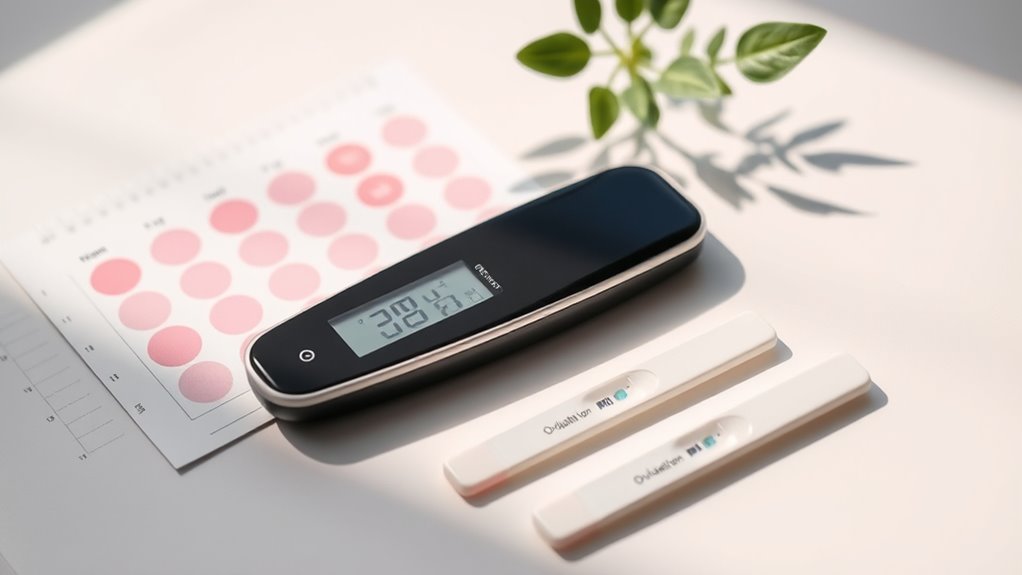
Ovulation predictor kits (OPKs) are a popular choice for those wanting to pinpoint their ovulation window accurately.
These over-the-counter tests detect the surge of luteinizing hormone (LH) in your urine, indicating ovulation is likely within 12 to 36 hours.
Here’s how to use them effectively:
- Start testing a few days before your expected ovulation.
- Test at the same time each day for consistency.
- Avoid using first morning urine, as LH levels fluctuate.
- Look for a test line as dark or darker than the control line for a positive result.
Timing Intercourse for Conception
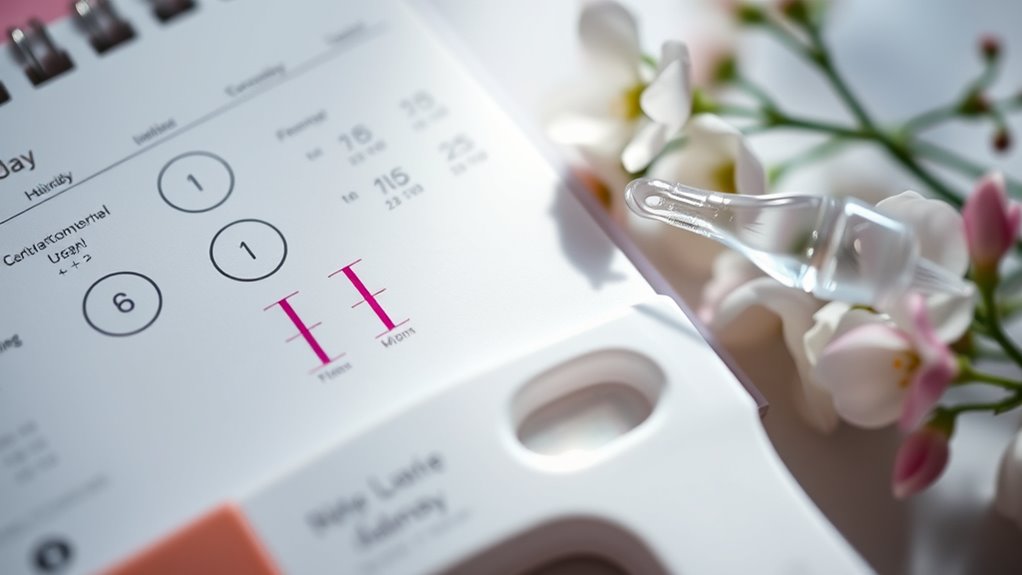
To increase your chances of conception, timing your intercourse around ovulation is key.
Aim to engage in sexual activity 1-2 days before ovulation and on the day itself, as the egg is only viable for a short time.
Understanding your fertile window and sperm lifespan can help you pinpoint the best days for conception.
Optimal Intercourse Timing
Understanding the best timing for intercourse can greatly boost your chances of conception.
To achieve the best timing, consider these key points:
- Intercourse should occur 1-2 days before ovulation and on the day of ovulation.
- Aim for intercourse during the fertile window, ideally 3-4 days before ovulation, since sperm can last up to 5 days.
- Utilize ovulation predictor kits to pinpoint the LH surge, indicating your most fertile days.
- Track changes in basal body temperature and cervical mucus to enhance your timing accuracy.
Fertile Window Identification
Identifying your fertile window is essential for maximizing your chances of conception, as it encompasses the days leading up to and including ovulation. This fertile time typically spans six days, starting five days before ovulation and ending on the day of ovulation.
Ovulation usually occurs about 14 days before your next period, but individual cycle lengths can vary. To enhance your chances, aim for intercourse during the two to three days before ovulation, ensuring sperm is present when the egg is released.
Monitor your cervical mucus, which becomes stretchy and clear like raw egg whites, to help pinpoint the best times. Additionally, consider using ovulation predictor kits to detect LH surges, providing precise indicators of your most fertile days.
Sperm Lifespan Considerations
Timing intercourse effectively is essential for conception, especially taking into account that sperm can survive in the female reproductive tract for 3 to 5 days.
To maximize your chances of pregnancy, focus on the fertile window, which spans from 5 days before ovulation to 1 day after.
Here are some key points to ponder:
- Engage in regular intercourse 3 to 4 days leading up to ovulation.
- Aim for sperm presence in the fallopian tubes during or just before ovulation.
- Track ovulation using basal body temperature, cervical mucus changes, or ovulation predictor kits.
- Understanding your cycle helps in identifying the best days for intercourse.
Hormonal Changes During Ovulation

As you approach the midpoint of your menstrual cycle, significant hormonal changes signal that ovulation is near. A surge in luteinizing hormone (LH) triggers the release of a mature egg from your ovary, usually around day 14.
Before ovulation occurs, rising estrogen levels lead to changes in your cervical mucus, making it clear, slippery, and stretchy—ideal for sperm movement.
After ovulation, progesterone levels rise to prepare your uterine lining for a potential pregnancy, while estrogen may fluctuate. These hormonal shifts can also cause physical symptoms like breast tenderness, bloating, and mild pelvic pain, known as mittelschmerz.
Tracking these changes can help you understand your cycle and identify your fertile window more effectively.
Seeking Help for Ovulation Issues
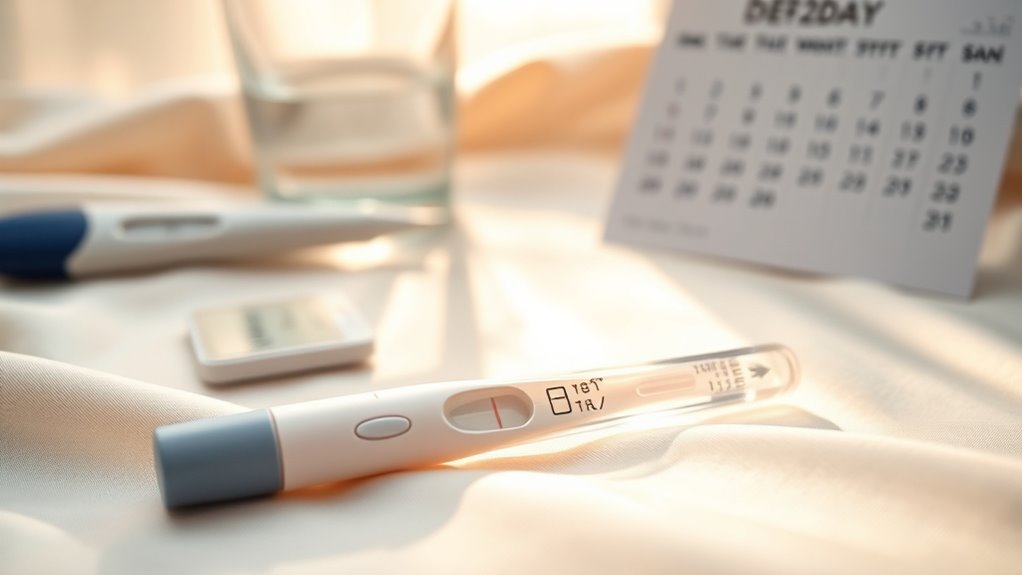
Are you struggling with ovulation issues? It’s important to seek help if you notice any of the following:
- Irregular menstrual cycles or significant variations in cycle length
- Inconsistent or absent ovulation symptoms like changes in basal body temperature or cervical mucus
- Trying to conceive for over 6 to 12 months without success
- Persistent ovulation pain (mittelschmerz) or lack of typical ovulation signs
These signs can indicate underlying health conditions that may affect your fertility health. Conditions like polycystic ovary syndrome (PCOS) or thyroid disorders can disrupt ovulation.
Signs of irregular ovulation may signal underlying health issues like PCOS or thyroid disorders that impact fertility.
Consulting a fertility specialist can help you identify these issues and create a tailored treatment plan, enhancing your chances of conception and overall reproductive well-being.
Don’t hesitate to reach out for support!
Frequently Asked Questions
How Do You Know When You Ovulate in Your Cycle?
You can tell when you ovulate by paying attention to your body.
Look for changes in your cervical mucus; it’ll become clear and stretchy, similar to raw egg whites.
You might notice a slight increase in your basal body temperature after ovulation, too.
Using ovulation predictor kits can help, as they detect the LH surge that indicates impending ovulation.
Finally, some women experience mild pelvic pain or changes in libido around this time.
What Are Ovulation Tracking Symptoms?
They say knowledge is power, and knowing ovulation tracking symptoms can give you valuable insight into your cycle.
You might notice changes in your cervical mucus, becoming stretchy and clear. Your basal body temperature will rise slightly after ovulation.
You could experience mittelschmerz, a mild abdominal cramp, or even an increase in libido. Light spotting may occur too.
Paying attention to these signs can help you understand your body’s rhythm better.
What Are the 7 Signs of Ovulation?
The seven signs of ovulation you might notice include changes in cervical mucus, which becomes clear and stretchy, a slight increase in your basal body temperature, mittelschmerz or mild cramps on one side, heightened libido, light spotting, breast tenderness, and mood swings.
Each sign signals hormonal changes in your body, indicating that you’re at your most fertile. Being aware of these signs can help you better understand your cycle.
How to Tell if You’re Actually Ovulating?
To tell if you’re actually ovulating, pay attention to your body.
You might notice a rise in your basal body temperature, clear and stretchy cervical mucus, or experience mild cramping on one side of your abdomen.
You could also use ovulation predictor kits to detect hormone surges.
Increased libido and breast tenderness are other signs.
Conclusion
In summary, tracking your ovulation is like steering through a map to your body’s natural rhythms; it helps you understand when you’re most fertile. By recognizing the signs, such as changes in cervical mucus and monitoring your basal body temperature, you’re empowered to take charge of your reproductive health. If you encounter any issues, don’t hesitate to seek help. Armed with knowledge, you can enhance your chances of conception and embrace the journey ahead.








